One
of the most characteristic facts of the Napolitan issue is the huge numbers
of forgeries of that time to cheat the postal service. In the overall panorama
of the Old States and of the old international philately this is not an exclusive
characteristic; what if indeed noticeable is the amount really huge of samples
produced. Just for the value of the 20 grana the forgeries of that time are
more common than the original pieces!
The printing of these forgeries, very coarse, is very easy to detect both
for the engraving not precise and approximate as well as for the color shades
completely different. They have been printed in engraving using plates probably
made of copper containing only one impression: this is evident from the fact
that there are no multiples of these forgeries as well as there are no pieces
showing parts of adjacent stamps.
Several were the forgery types prepared for the various values and often the
plates were also revisited with improvements.
They were printed on hand made paper found on the local market, papers of
different types, without watermark; some occasional partial manufacturer mark
can be found but the original watermark was never cloned.
The margins of these pieces are often irregular and narrow, most probably
because they were cut one by one: so, to find pieces with good margins is
not an easy task.
The forged values were the 2, 10 and 20 grana: most of these parts were used
in Naples and so huge diffusion lets to think that there was probably some
complicity by not so honest postal workers.
The oldest known date of use is June 18th 1859 (2 grana) and the most recent
is September 29th 1861 (20 grana)
Some parts are, as said, rather common, while other are very rare: very rare
when brand new and
on envelope not so common.
Here are in detail these forgeries: because I don't have of my own original
samples of all types I will use some example, even if not of high quality,
obtained from catalogues and books: I will be very grateful to everybody who
can offer to me images of missing examples.
Note: I identify only the main elements needed to distinguish
the different types even if the number of peculiar details is huge, just because
of the coarse manufacturing quality. I will leave on the side also the color
details and the printing type because as can be seen from the images they
cannot be confused with the original. Very detailed explanations can be found
in the unbeatable works of Emilio Diena (cfr. section "Bibliography").
2 GRANA
Three
type are known and catalogued.
The first one present the missing dots after
the "G" and has the number "2" in very high position and
bent to the left. Two varieties are known: the first one has the background
white, without any color spot while the second one, more common, has the background
in the whole full of spots and color dots (Fig. 1).
The second type presents the dots after the "G"
even if sometimes not so visible (specially the lower one). The number "2"
is in lower position, bigger and straight (Fig. 2).
The third type, obtained from the matrix revisited
of the first type, is again without dots (as in the first type) but the number
"2" is bigger and different. The first "N" of "NAPOLETANA"
is also smaller (Fig. 3).
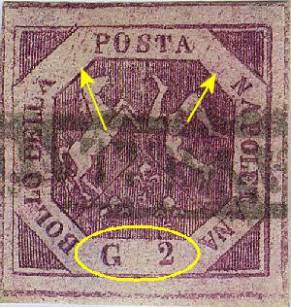 |
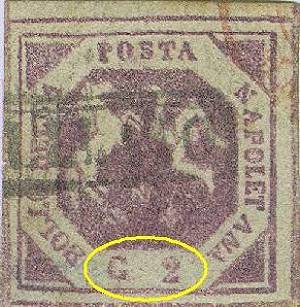 |
|
Fig.
1: first
type, second variation
|
Fig.
2:
second type
|
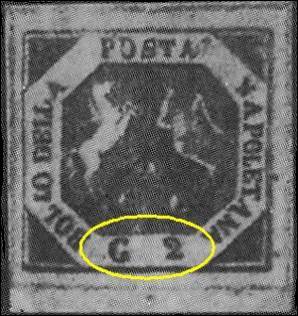 |
|
|
Fig.
3:
third type
(picture from "Catalogo Sassone Specializzato" ed. 2002) |
|
10 GRANA
Five
types are known and catalogued.
The first type has a color dot after the last
"A" of "NAPOLETANA" and has the top right corner smoothed
(Fig. 4).
The second type has a color trait inside the
"O" of "10" and the top right corner not smoothed (Fig.
5).
The third type has the words "BOLLO DELLA"
more close to the frame line underneath, in comparison to the original stamp,
the "0" of "10" is perfect and does not stretch out of
the corner of the upper frame (Fig. 6).
The fourth type has the two dots after the "G"
not in line, with the lower one shifted to the right; the "G" has
a peculiar shape too (Fig. 7).
The fifth type has the dots after the "G"
missing or just barely visible; on the top, outside the stamp, on the right
of "A" of "POSTA" there is always a color dot very evident
(Fig. 8).
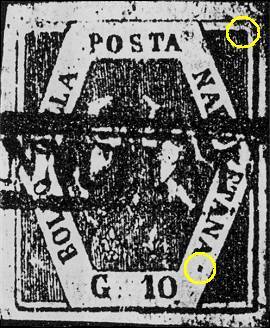 |
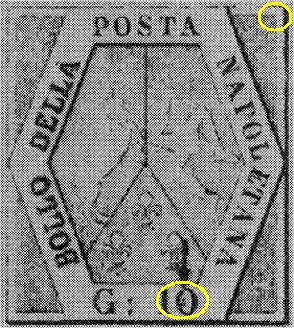 |
|
Fig.
4:
first type
|
Fig.
5:
second type
(picture from "Catalogo CEI" ed. 2001) |
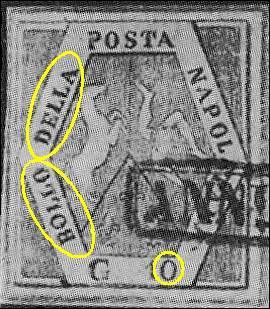 |
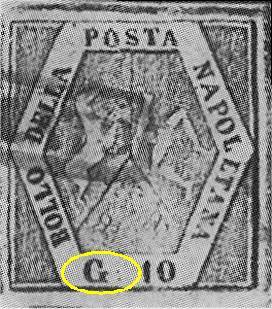 |
|
Fig.
6:
third type
|
Fig.
7:
fourth type
|
|
(pictures
from "Catalogo Sassone Specializzato" ed. 2002)
|
|
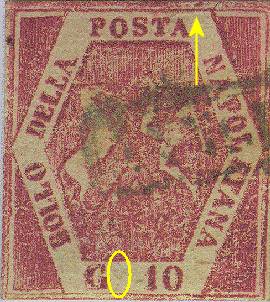
Fig.
8:
fifth type
20 GRANA
Seven (!)
types are known and catalogued.
The first one has the "D"
of "DELLA" very small in relationship with the other letters and
the vertical traits at left of this word is very spaced; very often has a
dot after the "O" of "BOLLO". It is the rarest of all
the forgeries (Fig. 9).
The second one has a color dot between the
"P" and the "O" of "NAPOLETANA"; at the
left of the "D" of "DELLA" the vertical line of the
triangle enters in the white part of the frame; the lower left angle with
lines bent to right; to the left of the letters "OL" of "NAPOLETANA"
in the external border, there is an engraving mark. Two varieties of this
forgery do exist: the first one has more clear printing, lower border
white and left margin with vertical row of color separated from the stamp
border; the second one has the bottom margin with a color line and the
left margin colored line touches the stamp edge (Fig. 10-10a).
In the third type the left external vertical
line goes beyond the horizontal one at the top; the triangle traits under
the word "POSTA" are more close to each other and form almost
a colored big spot (Fig. 11).
In the fourth type le numbers "2"
and "0" are clearly more spaced; as in the previous type the
vertical left external line goes beyond the horizontal one even if for
a smaller length (Fig. 12).
The fifth type has the horizontal upper external
frame line that goes beyond the vertical one; the upper horizontal lines
of the two upper triangles are at different height (the left one is lower)
- Fig. 13 -
The sixth type has the word "DELLA"
placed apart from the lower border raw and more close to the upper one;
the internal rhombus of the frame has the lower left line that goes beyond
the tip of the rhombus itself; the group of letters "GRA" is
very much to the right and close to the rhombus line of the internal frame
(Fig. 14).
In the seventh type the "0" of
"20" is small and open at top; the "G" of "GRA"
has a particular shape with the horizontal trait that ends at right well
beyond the vertical with the upper curved part of the letter (Fig.
15).
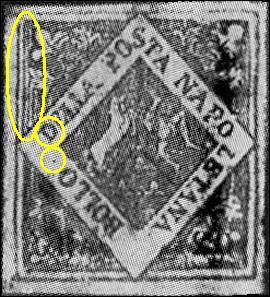
Fig.
9:
first type
(picture from "Catalogo Sassone Specializzato" ed.
2002)
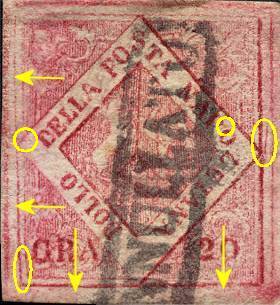 |
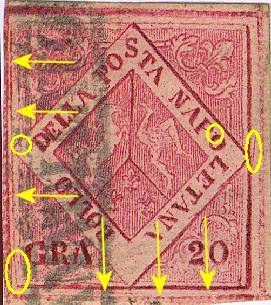 |
|
Fig.
10:
second type, first variety
|
Fig.
10a:
second type, second variety
|
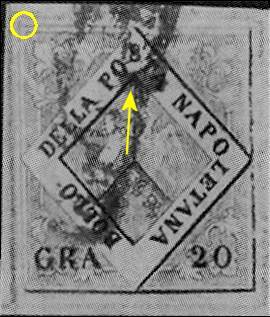 |
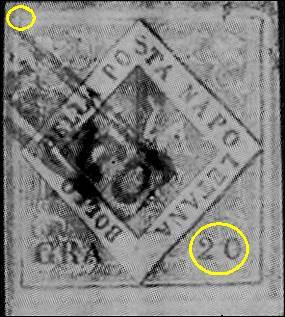 |
|
Fig.
11:
third type
|
Fig.
12:
fourth type
|
|
(pictures
from "Catalogo Sassone Specializzato" ed. 2002)
|
|
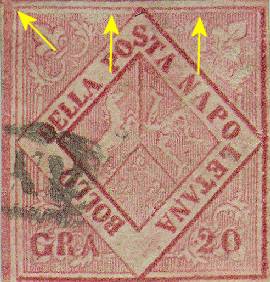 |
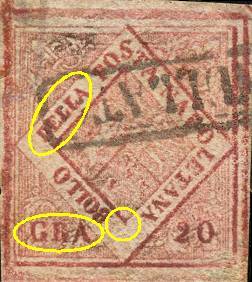 |
|
Fig.
13:
fifth type
|
Fig.
14:
sixth type
|
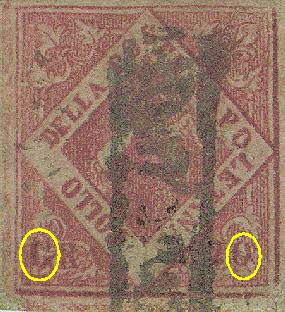
Fig.
15:
seventh type